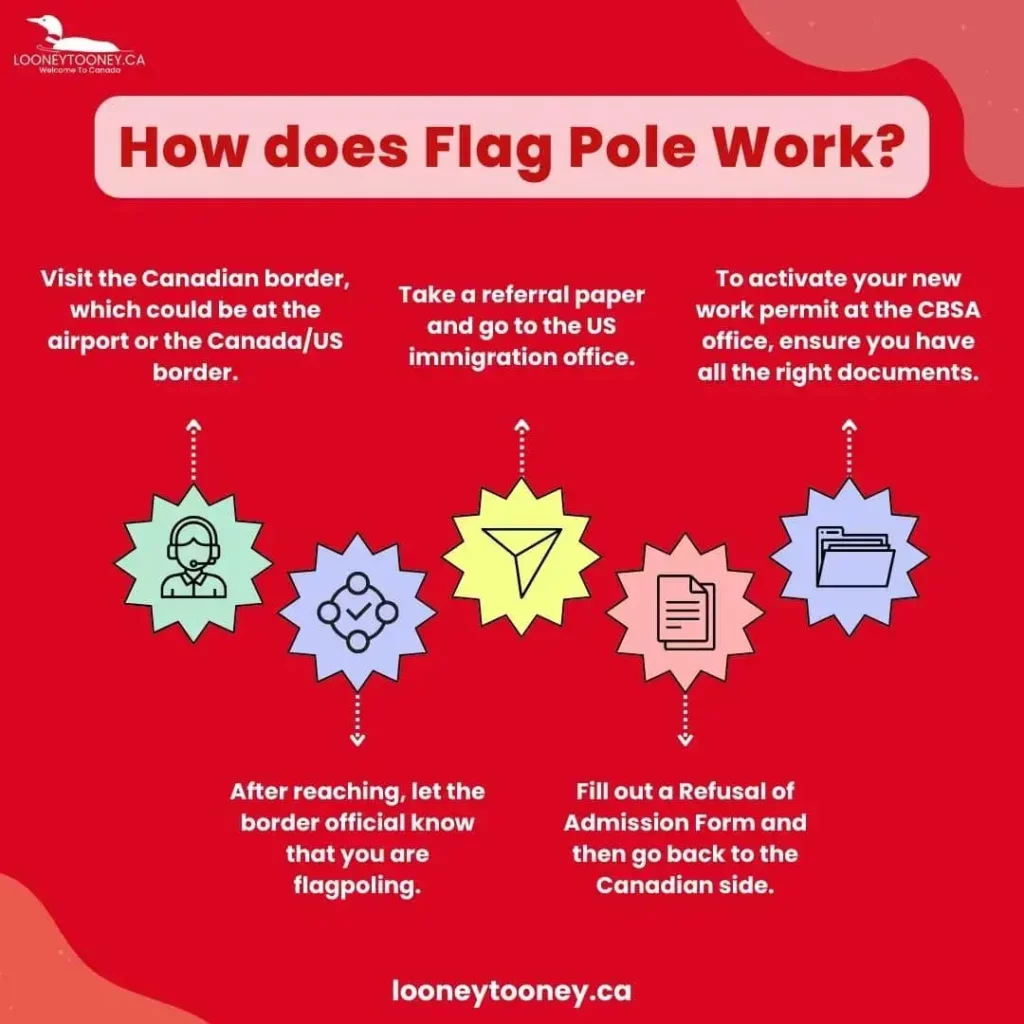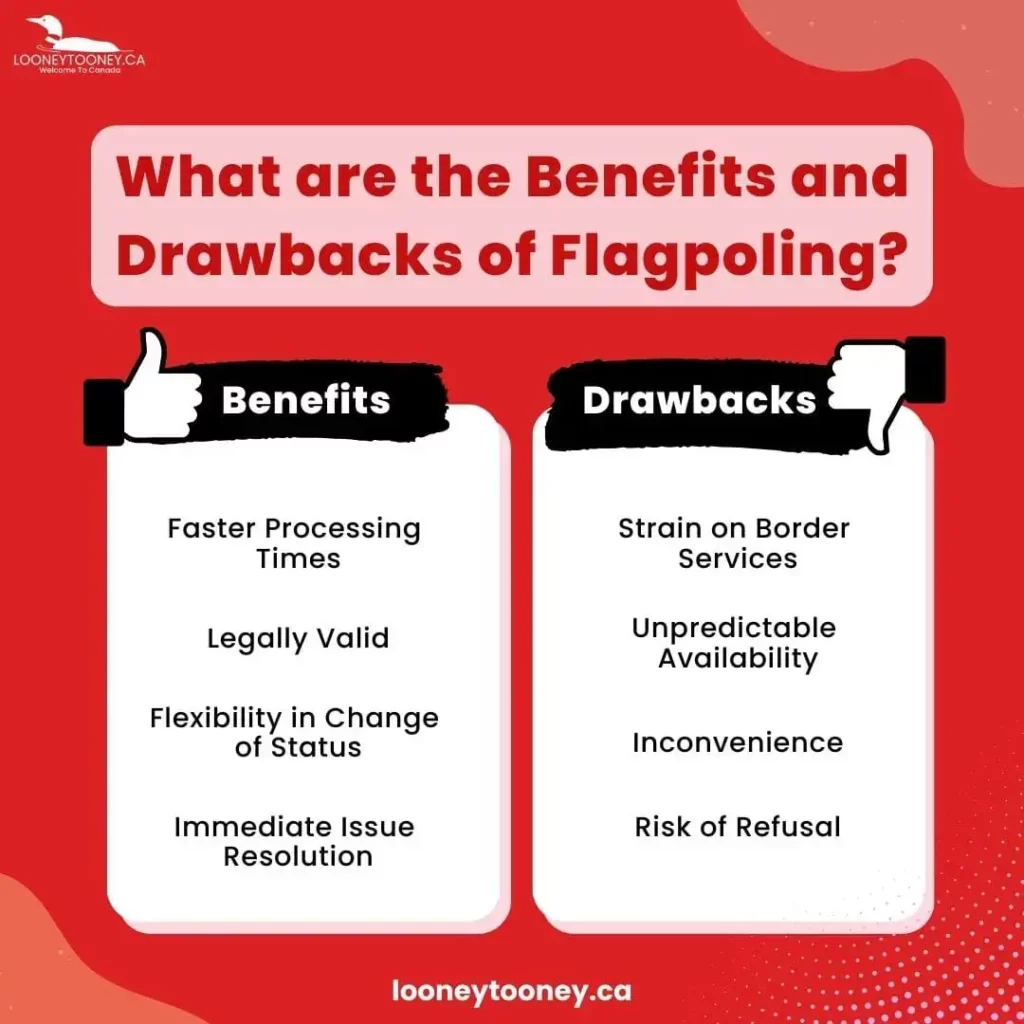As individuals look for efficient ways to handle Canada’s immigration process, “flagpoling” has become a significant strategy. This unique approach involves temporarily leaving and returning to the country to activate new immigration status or renew permits. In this article, we will explore the concept of flagpoling in more detail, taking a closer look at its benefits, drawbacks, and the criteria for eligibility. Keep scrolling to discover more about flagpoling in Canada.
Table of Contents
- What is Flagpoling in Canada?
- Flagpoling in Canada: Trends and Considerations
- Who is Eligible for Flagpole in Canada?
- How does Flag Pole Work?
- What are the Benefits and Drawbacks of Flagpoling in Canada?
- Conclusion on Flagpoling in Canada
- FAQs on Flagpoling in Canada
What is Flagpoling in Canada?
Flagpoling is a term used when people with temporary status in Canada leave the country, return on the same day, and get immediate immigration services. It’s completely legal and can be done at any point of entry, but is generally done at land border crossings. Individuals undertake this process to modify their immigration status, such as transitioning from a visitor to a work or study permit, without leaving Canada for a long time.
A big advantage of using flagpoling for a visa is that it skips the long processing times of regular applications. Instead of waiting, your visa application is processed right away. During flagpoling, you need to hand over your documents directly to an immigration officer in person. If there’s any issue with the application, the officer will inform you, and the errors can be corrected without unnecessary delays. In contrast, when using regular application channels, a mistake or error might lead to delays in processing your application.
Flagpoling in Canada: Trends and Considerations
According to data from the Canada Border Services Agency (CBSA), 21,452 people engaged in flagpoling in 2022. Although CBSA encourages individuals to apply online through Immigration, Refugees and Citizenship Canada’s (IRCC) website to avoid flagpoling, it has become widespread. The CBSA has even designated specific dates and times at certain border crossings to accommodate those intending to flagpole. This practice is on the rise due to the persistent backlog in IRCC’s processing.
Despite efforts by CBSA to limit flagpoling due to the additional strain on border services, it is important to note that flagpoling is a legal process, and application processing is conducted on the spot.
Who is Eligible for Flagpole in Canada?
Flagpoling is commonly utilized by individuals holding study and work permits seeking permit renewals. However, several public policies now extended this option to other programs. Flagpoling is also recognized as a method for validating Permanent Resident (PR) status, offering a quick and cost-effective alternative to waiting for an office appointment.
The following foreign nationals are eligible to engage in flagpoling in Canada:
- Residents of visa-exempt countries with a Labour Market Impact Assessment (LMIA) exempt job.
- Residents of visa-exempt countries holding a positive LMIA.
- Residents of the U.S., St. Pierre & Miquelon, and Greenland.
- Residents of visa-required countries already holding a study or work permit (specifically for renewal purposes).
How does Flag Pole Work?
To flagpole and apply for a work permit or activate one, you need to visit the Canadian border, which could be at the airport or the Canada/US border. When you reach the border booth, let the border official know that you are flagpoling.
They will give you a referral paper and take you to the US immigration office. There, you will fill out a Refusal of Admission Form and then be sent back to the Canadian side. Follow the provided directions.
To activate your new work permit at the CBSA office, make sure you have all the right documents with you, like proof of funds, the POE letter, forms, job offer letter, and other required documents.

What are the Benefits and Drawbacks of Flagpoling in Canada?
When deciding whether to use the flagpoling method, it’s essential to consider personal circumstances and preferences. Individuals should evaluate their urgency for document processing, willingness to travel to the border, and potential risks associated with the process. Consulting with an immigration professional can offer personalized guidance based on specific situations.
Understanding both the benefits and drawbacks is crucial for making a well-informed choice regarding the flagpoling approach.
Advantages of Flagpoling
Here are several advantages associated with the practice of flagpoling:
- Faster Processing Times: Flagpoling offers a quicker application processing time, often completed in under 30 minutes. This is especially advantageous for those in urgent need of documents.
- Legal Validity: The flagpoling process is entirely legal, and its usage does not hinder future travel to the US.
- Flexibility in Change of Status: Flagpoling allows for a swift change of immigration status, such as switching from a visitor status to a work or study permit.
- Immediate Issue Resolution: Direct interaction with immigration officers during the flagpoling process enables immediate issue resolution. If there are any problems with the application, they can be addressed on the spot, reducing delays.

Risks of Flagpoling
Here are some of the drawbacks associated with the practice of flagpoling in Canada:
- Strain on Border Services: The Canadian government discourages flagpoling due to the additional strain it puts on border services. With already lengthy wait times at the Canadian-US border, flagpoling contributes to increased queues.
- Unpredictable Availability: Busier crossings, particularly in Ontario and Quebec, only permit flagpoling on certain days and time periods. Additionally, flagpoling was entirely prohibited during pandemic periods and deemed non-essential travel.
- Inconvenience: Traveling to the border incurs additional costs and time. There can be long wait times at the border, especially during peak periods, adding to the inconvenience.
- Risk of Refusal: Individuals flagpoling may face refusal into Canada due to factors like incomplete documents or past immigration violations. Individuals with valid permits can usually resolve issues that may arise, but those with expired permits face the risk of being deported.
Conclusion on Flagpoling in Canada
To sum up, flagpoling in Canada serves as a legal and efficient method for individuals with temporary status to either activate a new status or renew their permits. For those who meet the eligibility criteria and are considering flagpoling, it’s vital to delve into the intricacies of the process, seek advice from immigration professionals, and carefully assess personal circumstances.
FAQs on Flagpoling in Canada
Explore some commonly asked questions regarding flagpoling in Canada.
Q. Is flagpoling legal in Canada?
A. Yes, flagpoling in Canada is legal. The term flagpoling denotes the legal practice where individuals with temporary status exit Canada, cross the border into the United States, and re-enter Canada to avail same-day immigration services.
Q. How risky is flagpoling?
A. Engaging in flagpoling carries a risk of refusal into Canada. In certain situations, individuals undertaking flagpoling may face entry denial due to factors like incomplete or inaccurate documents, as well as past immigration violations.
Q. Who is eligible for flagpole in Canada?
A. Flagpoling is commonly utilized by study and work permit holders seeking to renew their permits. However, recent public policies have expanded this option to include other programs. Additionally, flagpoling is permitted as a method of validating permanent resident status.
Q. What are the advantages of flagpoling in Canada?
A. Flagpoling offers faster processing, typically completed within 30 minutes, ensuring a swift alternative for urgent document needs. It’s entirely legal, avoiding consequences for future US travel, and provides flexibility, allowing quick changes, such as switching from a visitor to a work or study permit.
Q. How does flag pole work?
A. To flagpole, you need to visit the Canadian border and tell the border official you want to apply for or activate a work permit. Then get a referral paper, and go to the US immigration office. Fill out a Refusal of Admission Form, come back to the Canadian side, and activate the work permit at the CBSA office with all your documents ready.
Take a look at these additional articles:
- Work Permits in Canada: Types, Eligibility, & Process
- PR Canada: Benefits, Eligibility, Application Steps & More
- Canada Study Permit: Application Guide for International Students
- Refugee in Canada: Check Steps, Eligibility & Other Details
For more information, stay tuned to LooneyTooney.ca. By staying connected, you will get valuable insights and stay updated on the latest developments.





